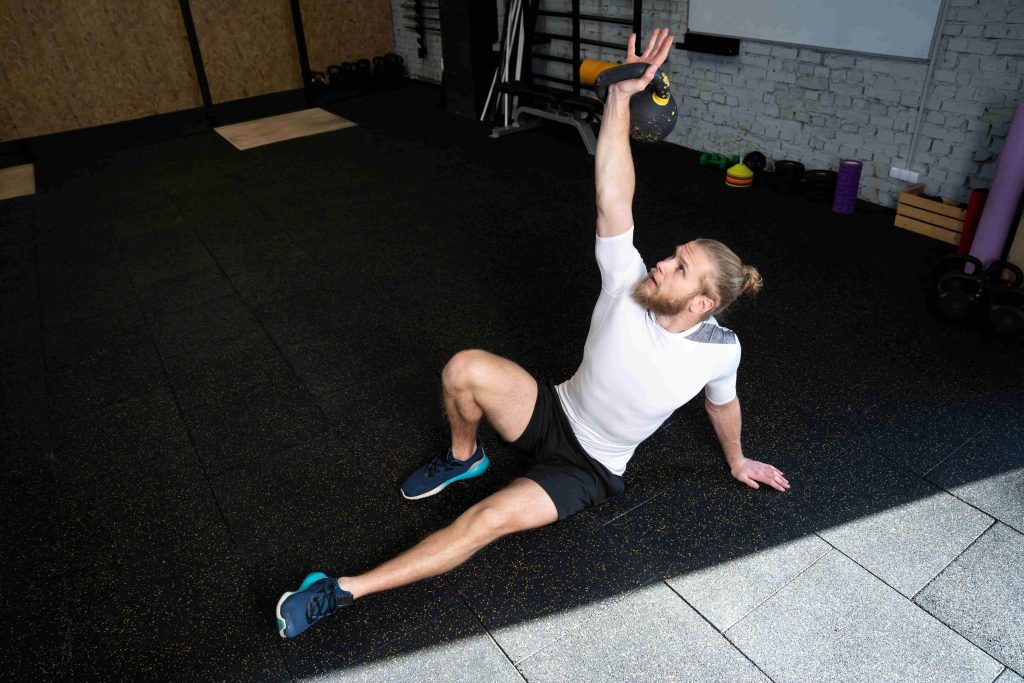12 de August de 2025
Kettlebell Turkish Get-Up: Exercise Guide, Tips and Benefits
The Kettlebell Turkish Get-Up (TGU) is one of the most complete, technical, and rewarding exercises you can incorporate into your training. Combining mobility, stability, coordination, and strength, the TGU is not just an exercise—it’s a movement pattern that demands precision and focus.
Whether you’re a strength and conditioning coach, an athlete, or a fitness enthusiast, mastering the Turkish Get-Up can provide unmatched benefits in injury prevention, core development, and overall athleticism.

What Are Kettlebell Turkish Get-Ups?
The Turkish Get-Up is a full-body movement that takes you from lying flat on the floor to standing upright—all while holding a kettlebell overhead. It dates back centuries and has been used by wrestlers and strongmen for building total-body control.
Unlike traditional lifts, the TGU requires mobility, stability, and strength through multiple planes of motion, making it a unique and functional tool in any program.
How to Do Kettlebell Turkish Get-Ups Properly
- Starting Position: Lie on your back with the kettlebell in your right hand, arm locked out. Right knee bent, left leg extended. Left arm on the floor at about 45°.
- Roll to Elbow: Drive through your right heel and roll onto your left elbow, keeping eyes on the kettlebell.
- Post to Hand: Extend your left arm and post up to your hand.
- Hips High: Bridge your hips up high, creating space to sweep the left leg.
- Sweep the Leg: Bring your left leg behind into a half-kneeling position.
- Half-Kneeling to Stand: Align your torso, then lunge up into standing, maintaining the kettlebell overhead.
- Reverse the Steps: To descend, simply reverse the exact sequence under control.
Technique Tips
- Keep your gaze fixed on the kettlebell throughout.
- Move slowly and deliberately.
- Start with a light kettlebell or even bodyweight until the sequence is automatic.
- Practice each phase independently if needed.
Muscles Worked by Kettlebell Turkish Get-Ups
- Core: Rectus abdominis, obliques, transverse abdominis
- Shoulders and scapular stabilizers: Deltoids, rotator cuff, serratus anterior
- Hips and glutes: Gluteus maximus and medius, hip flexors
- Legs: Quads, hamstrings, calves
- Back and lats
- Grip and forearm stabilizers
Benefits of Kettlebell Turkish Get-Ups
- Enhances shoulder stability and mobility, crucial for injury prevention and overhead performance.
- Improves core control and anti-rotational strength, developing the ability to stabilize under dynamic movement.
- Develops full-body coordination and proprioception across multiple planes of motion.
- Builds resilience and joint integrity, particularly in the shoulders, hips, and knees.
- Encourages conscious movement and precise motor control, improving neuromuscular efficiency.
- Serves as a movement screen to assess mobility and asymmetries, helping coaches individualize corrective strategies.
- Perfectly complements a Strength and Conditioning program—learn more in our Strength and Conditioning Guide.
- Helps monitor and manage training fatigue, an essential factor in programming—read more about fatigue in training.
Common Mistakes to Avoid
- Letting the kettlebell drift away from your centerline, which compromises shoulder safety.
- Rushing through transitions instead of maintaining control.
- Lack of core engagement during key phases like the bridge and leg sweep.
- Not locking out the elbow fully, risking instability overhead.
- Poor wrist positioning—avoid excessive grip tension and keep the bell resting comfortably on the forearm.
- Skipping progressions—some athletes jump into heavy loads before mastering movement quality.
Variations of Kettlebell Turkish Get-Ups
- Bodyweight TGU (with a shoe or foam block): Ideal for beginners to practice form and control.
- Double Kettlebell TGU: Increases core and shoulder demands, requiring symmetrical strength.
- Barbell TGU (advanced): Great for strength athletes looking to challenge total-body stability.
- Half Get-Up: Focuses on the initial phases—great for warm-ups and teaching segments.
- Tempo TGU: Emphasizes time under tension to develop endurance and joint awareness.
- Paused TGU: Pause at each step for a 3–5 second hold to reinforce stability and control.

How to Include Kettlebell Turkish Get-Ups in Your S&C Workout
For beginners: Start with 2-3 reps per side using light weight or a shoe to practice control.
For athletes or advanced users: 3-5 sets of 1-3 reps per side, loaded progressively.
In warm-ups: Unloaded TGUs can be great mobility and activation tools.
In conditioning blocks: Use with moderate loads and continuous flow for time (e.g., 5 min EMOM).
FAQs About Kettlebell Turkish Get-Ups
What muscles do kettlebell Turkish get-ups work?
They work the entire body, especially the core, shoulders, hips, and stabilizing muscles throughout the trunk and limbs.
What is the benefit of the Turkish get-up?
It builds total-body control, core strength, joint stability, and mobility—making it one of the most functional exercises for athletes.
What weight kettlebell for Turkish get-ups?
Start light. Most women begin with 8–12 kg and men with 12–16 kg. Form and control always come first.
How to hold a kettlebell for Turkish get-up?
Keep the wrist neutral with the bell resting on the forearm. Your grip should be firm but not overly tight.
Is the Turkish get-up good for abs?
Absolutely. It engages your entire core, especially during the transitions, making it one of the most effective ab exercises.
Can you do Turkish get-ups every day?
Yes—if volume is controlled and you’re focused on form. Many athletes use it daily in warm-ups or mobility routines.
